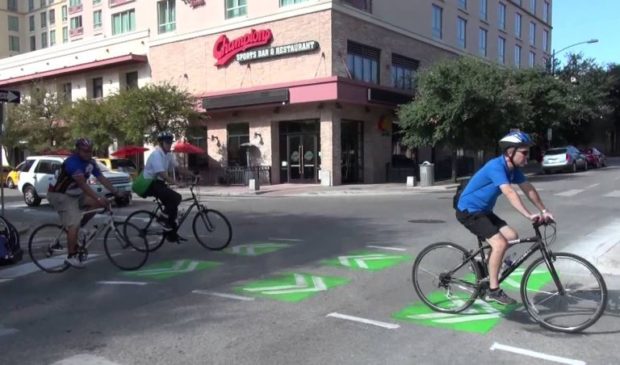Advocates say bond funding for Bicycle Master Plan could diversify local biking community
Thursday, June 23, 2016 by
Audrey McGlinchy, KUT Sharmar Mohamed Hassan doesn’t know the words in English to describe his bicycle. So he uses his native language, Somali, to tell me it’s a green road bike. And it’s his primary form of transportation in Austin — which, at times, can be a little touch-and-go.
“I’m feeling afraid because there’s no bike lanes and there’s cars on the road,” said Hassan. “Sometimes they yield to you. Sometimes they want to hit you.”
Hassan started biking a few months after moving to Austin in September 2014. He got his first job washing dishes at the Driskill Hotel. When working late, he often left the hotel around 3 a.m. He didn’t own a car, and there were no buses at that hour, so biking became the best option.
Hassan said that in his home nation of Somalia, a person’s class is easily discernible based on how he or she gets around.
“If you are walking on the street, people consider you to be a very poor class because you cannot afford to have a car or any form of transportation,” he said. In the U.S., he said, determining class by mode of transportation is much trickier.
City Council members must soon choose which one of a handful of bond proposals they’d like to place on a November ballot. While the plans vary in total funding — from $500 million to $720 million — and how that money is allocated, each of the proposals promises to put some money toward the city’s Bicycle Master Plan.
Bike advocates say this funding has the potential to benefit a diverse group of current cyclists.
In a report released by local non-profit Bike Austin in April, the advocacy group wrote, “Despite the common perception of bicycling as an activity of the affluent, people making less than $25,000 a year account for roughly 40 percent of the Austinites who use bicycles regularly to get to work.”
But that number is a little problematic. While the group used census data, the way the government categorizes commuting makes isolating specific modes of transportation challenging. When organizing commute types by income bracket, the census groups bicycle commuters in with those who get to work by taxi or motorcycle.
Regardless, Miller Nuttle with Bike Austin said that from working with local bikers, he knows the community is diverse.
“In Austin, as is true in any city, you see people from all backgrounds riding bikes,” said Nuttle, advocacy director at Bike Austin. “It’s actually one of these things that cuts across a lot of the socioeconomic divides that you might see in other parts of our culture.”
While a more complete biking landscape in Austin — including protected bike lanes and complete trails – would be significant from a safety standpoint, Bicycle Advisory Council member Tom Wald said funding for the plan would more than anything help further diversify Austin’s bike community.
“There is existing diversity and that’s important to recognize,” said Wald, who spoke for himself and not the city’s advisory council. “But the plan actually would bring more people to bicycling than (who) currently regularly bike as it is.”
According to Wald, 2014 updates to the plan focused on short trips and safety — two things Wald and city staff say will encourage more people to bike — and further protect those for whom biking may not be a choice.
You're a community leader
And we’re honored you look to us for serious, in-depth news. You know a strong community needs local and dedicated watchdog reporting. We’re here for you and that won’t change. Now will you take the powerful next step and support our nonprofit news organization?









